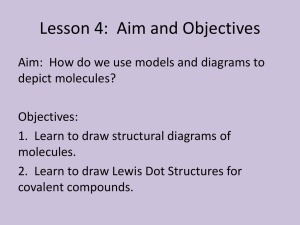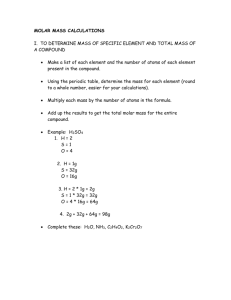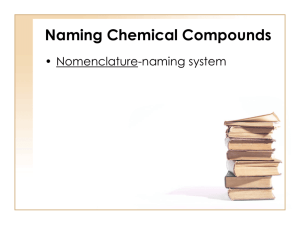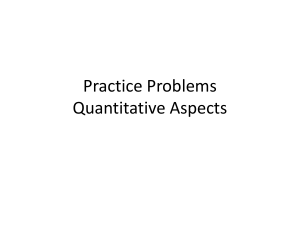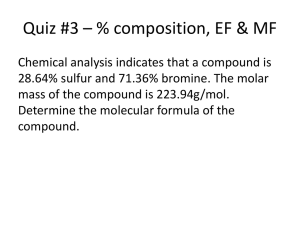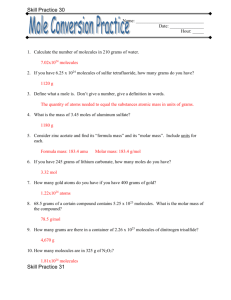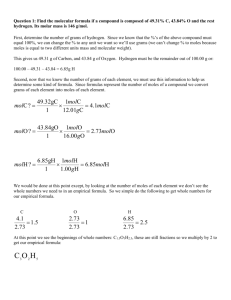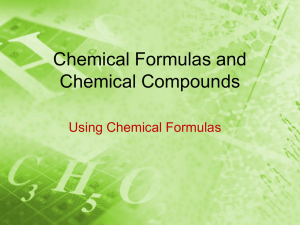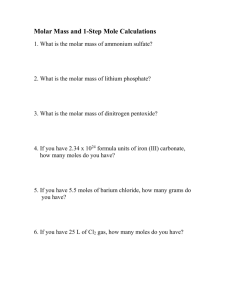Definitions
advertisement
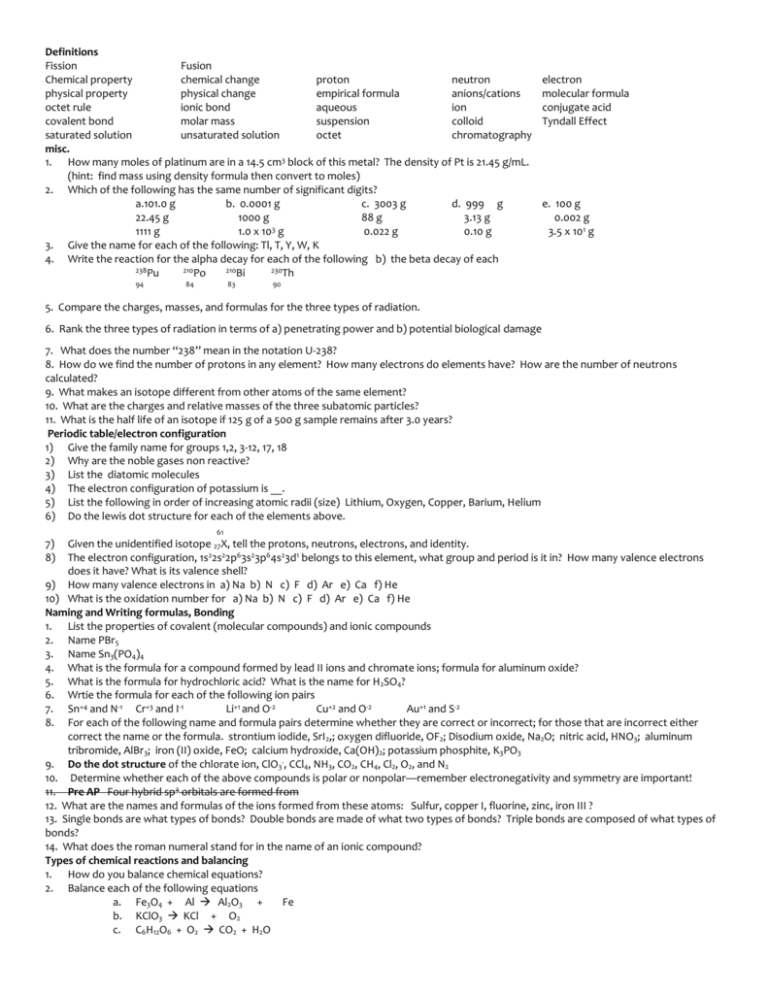
Definitions Fission Fusion Chemical property chemical change proton neutron physical property physical change empirical formula anions/cations octet rule ionic bond aqueous ion covalent bond molar mass suspension colloid saturated solution unsaturated solution octet chromatography misc. 1. How many moles of platinum are in a 14.5 cm3 block of this metal? The density of Pt is 21.45 g/mL. (hint: find mass using density formula then convert to moles) 2. Which of the following has the same number of significant digits? a.101.0 g b. 0.0001 g c. 3003 g d. 999 g 22.45 g 1000 g 88 g 3.13 g 1111 g 1.0 x 103 g 0.022 g 0.10 g 3. Give the name for each of the following: Tl, T, Y, W, K 4. Write the reaction for the alpha decay for each of the following b) the beta decay of each 238Pu 210Po 210Bi 230Th 94 84 83 electron molecular formula conjugate acid Tyndall Effect e. 100 g 0.002 g 3.5 x 101 g 90 5. Compare the charges, masses, and formulas for the three types of radiation. 6. Rank the three types of radiation in terms of a) penetrating power and b) potential biological damage 7. What does the number “238” mean in the notation U-238? 8. How do we find the number of protons in any element? How many electrons do elements have? How are the number of neutrons calculated? 9. What makes an isotope different from other atoms of the same element? 10. What are the charges and relative masses of the three subatomic particles? 11. What is the half life of an isotope if 125 g of a 500 g sample remains after 3.0 years? Periodic table/electron configuration 1) Give the family name for groups 1,2, 3-12, 17, 18 2) Why are the noble gases non reactive? 3) List the diatomic molecules 4) The electron configuration of potassium is __. 5) List the following in order of increasing atomic radii (size) Lithium, Oxygen, Copper, Barium, Helium 6) Do the lewis dot structure for each of the elements above. 61 7) 8) Given the unidentified isotope 27X, tell the protons, neutrons, electrons, and identity. The electron configuration, 1s22s22p63s23p64s23d1 belongs to this element, what group and period is it in? How many valence electrons does it have? What is its valence shell? 9) How many valence electrons in a) Na b) N c) F d) Ar e) Ca f) He 10) What is the oxidation number for a) Na b) N c) F d) Ar e) Ca f) He Naming and Writing formulas, Bonding 1. List the properties of covalent (molecular compounds) and ionic compounds 2. Name PBr5 3. Name Sn3(PO4)4 4. What is the formula for a compound formed by lead II ions and chromate ions; formula for aluminum oxide? 5. What is the formula for hydrochloric acid? What is the name for H2SO4? 6. Wrtie the formula for each of the following ion pairs 7. Sn+4 and N-1 Cr+3 and I-1 Li+1 and O-2 Cu+2 and O-2 Au+1 and S-2 8. For each of the following name and formula pairs determine whether they are correct or incorrect; for those that are incorrect either correct the name or the formula. strontium iodide, SrI2,; oxygen difluoride, OF2; Disodium oxide, Na2O; nitric acid, HNO3; aluminum tribromide, AlBr3; iron (II) oxide, FeO; calcium hydroxide, Ca(OH)2; potassium phosphite, K3PO3 9. Do the dot structure of the chlorate ion, ClO3-, CCl4, NH3, CO2, CH4, Cl2, O2, and N2 10. Determine whether each of the above compounds is polar or nonpolar—remember electronegativity and symmetry are important! 11. Pre AP Four hybrid sp3 orbitals are formed from 12. What are the names and formulas of the ions formed from these atoms: Sulfur, copper I, fluorine, zinc, iron III ? 13. Single bonds are what types of bonds? Double bonds are made of what two types of bonds? Triple bonds are composed of what types of bonds? 14. What does the roman numeral stand for in the name of an ionic compound? Types of chemical reactions and balancing 1. How do you balance chemical equations? 2. Balance each of the following equations a. Fe3O4 + Al Al2O3 + Fe b. KClO3 KCl + O2 c. C6H12O6 + O2 CO2 + H2O PI3 + __ H2O __ H3PO3 + __ HI The incandescent white of fireworks displays is caused by the formation of tetraphosphorus decoxide, which occurs by the combustion of phosphorus. The reaction is: P (s) + O2 (g) P4O10 f. Fe + O2 Fe2O3 3. Predict the products for a decomposition reaction of lead (IV) oxide 4. Pre-AP Predict the primary products created during the reaction of magnesium and hydrochloric acid in aqueous solution.--- during the reaction of chloric acid and sodium hydroxide in aqueous solution. 5. Combustion reactions can be recognized by the presence of __ as a reactant. 6. Pre-AP Predict what happens when zinc is placed in water 7. Pre-AP Predict the products for the following reactions (hint use the activity series) a. Copper and hydrochloric acid b. Zinc and nitric acid c. Lead and sodium sulfate d. Nickel and barium nitrate 8. Pre-AP What is the net ionic equation for the precipitation reaction between silver nitrate solution and sodium sulfide solution? 9. Pre-AP Which ions do NOT appear in the net ionic equation for the precipitation reaction involving solutions of Zn(NO3)2 and Na3PO4? Formula stoichiometry (percent comp, EF, MF, moles, representative particles, grams, molar mass) 1. Calculate the percent composition for Na2O 2. The number of moles in 45.96 grams of NaNO3 is 3. The percent of water in copper II sulfate pentahydrate is: 4. What is the molar mass of ethyl alcohol, CH5OH? 5. What is the empirical formula for a compound made from 259.2 g of F and 40.8 g of C? 6. How many grams of CS2 are present in 10.0 mol? 7. To find the molecular formula from the empirical formula one must first know the compound’s ___________. 8. A compound’s empirical formula is CH. The molecular mass of this compound is 26.0 grams. What is the molecular formula? 9. The number of water molecules in 36.02 grams of water is: 10. The molar mass of MgI2 is 11. A compound contains 259.2 g of F and 40.8 g of C. Calculate the percent composition for this compound. 12. Determine the molecular formula for a compound made up of 54.5 % carbon, 13.6 % hydrogen, and 31.8 % nitrogen if the molar mass of the compound equals 88 grams. Stoichiometry 1. The coefficients in a balanced chemical equation represent the 2. In the reaction, 2Al2O3 4Al + 3O2 the ratio of moles of aluminum to oxygen is Matter & Metrics; Chromatography 1. Classify these materials as homogeneous or heterogeneous mixtures: sugar water, soil, steel, air, salt water, milk. 2. Classify as physical or chemical changes: 3. What is the density of water? 4. Will mercury ( d = ________ g/mL) sink or float in water? Why? 5. Give the mathematical answer to these problems in scientific notation: a) 9 x 1021) / (3 x 1019) b) (32 x 104) x (2 x 10-3) 6. List these metric prefixes from smallest to largest: Kilo, deci, micro, hecta, milli, centi, deka 7. 1 mL = ______ cm3 = _________cc 8. What is the purpose of chromatography? 9. On what is chromatography based? d. e.


